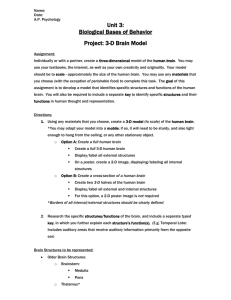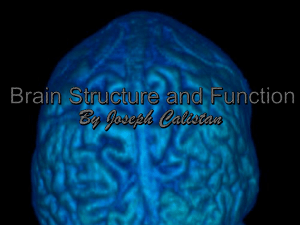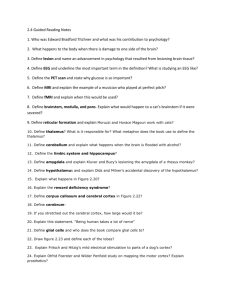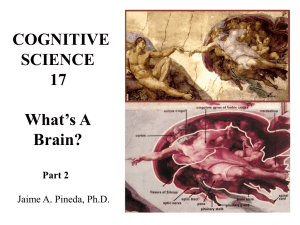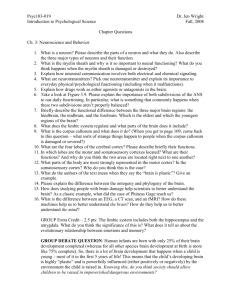A Review on Music-Evoked Emotional Processing in the Brain:
advertisement
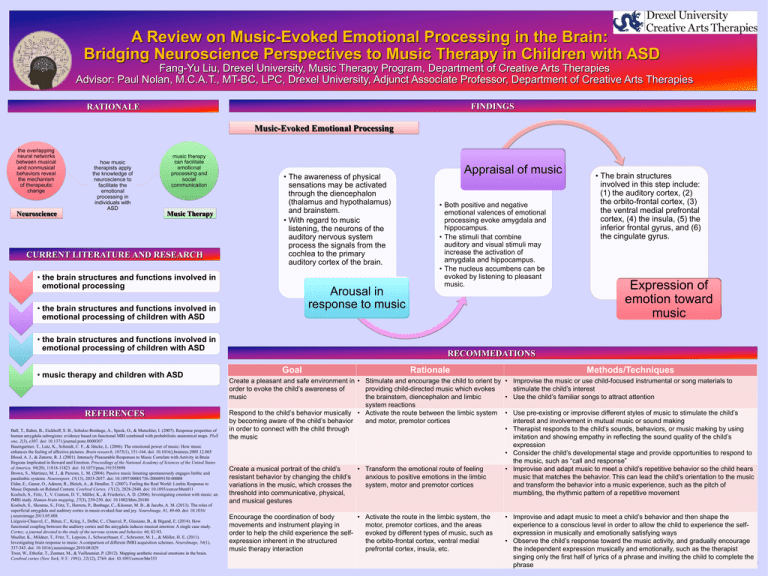
A Review on Music-Evoked Emotional Processing in the Brain: Bridging Neuroscience Perspectives to Music Therapy in Children with ASD Fang-Yu Liu, Drexel University, Music Therapy Program, Department of Creative Arts Therapies Advisor: Paul Nolan, M.C.A.T., MT-BC, LPC, Drexel University, Adjunct Associate Professor, Department of Creative Arts Therapies FINDINGS RATIONALE Music-Evoked Emotional Processing the overlapping neural networks between musical and nonmusical behaviors reveal the mechanism of therapeutic change Neuroscience how music therapists apply the knowledge of neuroscience to facilitate the emotional processing in individuals with ASD music therapy can facilitate emotional processing and social communication Music Therapy CURRENT LITERATURE AND RESEARCH • The awareness of physical sensations may be activated through the diencephalon (thalamus and hypothalamus) and brainstem. • With regard to music listening, the neurons of the auditory nervous system process the signals from the cochlea to the primary auditory cortex of the brain. • the brain structures and functions involved in emotional processing Arousal in response to music • the brain structures and functions involved in emotional processing of children with ASD • the brain structures and functions involved in emotional processing of children with ASD • music therapy and children with ASD REFERENCES Ball, T., Rahm, B., Eickhoff, S. B., Schulze-Bonhage, A., Speck, O., & Mutschler, I. (2007). Response properties of human amygdala subregions: evidence based on functional MRI combined with probabilistic anatomical maps. PloS one, 2(3), e307. doi: 10.1371/journal.pone.0000307 Baumgartner, T., Lutz, K., Schmidt, C. F., & Jäncke, L. (2006). The emotional power of music: How music enhances the feeling of affective pictures. Brain research, 1075(1), 151-164. doi: 10.1016/j.brainres.2005.12.065 Blood, A. J., & Zatorre, R. J. (2001). Intensely Pleasurable Responses to Music Correlate with Activity in Brain Regions Implicated in Reward and Emotion. Proceedings of the National Academy of Sciences of the United States of America, 98(20), 11818-11823. doi: 10.1073/pnas.191355898 Brown, S., Martinez, M. J., & Parsons, L. M. (2004). Passive music listening spontaneously engages limbic and paralimbic systems. Neuroreport, 15(13), 2033-2037. doi: 10.1097/00001756-200409150-00008 Eldar, E., Ganor, O., Admon, R., Bleich, A., & Hendler, T. (2007). Feeling the Real World: Limbic Response to Music Depends on Related Content. Cerebral Cortex, 17(12), 2828-2840. doi: 10.1093/cercor/bhm011 Koelsch, S., Fritz, T., V. Cramon, D. Y., Müller, K., & Friederici, A. D. (2006). Investigating emotion with music: an fMRI study. Human brain mapping, 27(3), 239-250. doi: 10.1002/hbm.20180 Koelsch, S., Skouras, S., Fritz, T., Herrera, P., Bonhage, C., Küssner, M. B., & Jacobs, A. M. (2013). The roles of superficial amygdala and auditory cortex in music-evoked fear and joy. NeuroImage, 81, 49-60. doi: 10.1016/ j.neuroimage.2013.05.008 Liégeois-Chauvel, C., Bénar, C., Krieg, J., Delbé, C., Chauvel, P., Giusiano, B., & Bigand, E. (2014). How functional coupling between the auditory cortex and the amygdala induces musical emotion: A single case study. Cortex; a journal devoted to the study of the nervous system and behavior, 60, 82-93. Mueller, K., Mildner, T., Fritz, T., Lepsien, J., Schwarzbauer, C., Schroeter, M. L., & Möller, H. E. (2011). Investigating brain response to music: A comparison of different fMRI acquisition schemes. NeuroImage, 54(1), 337-343. doi: 10.1016/j.neuroimage.2010.08.029 Trost, W., Ethofer, T., Zentner, M., & Vuilleumier, P. (2012). Mapping aesthetic musical emotions in the brain. Cerebral cortex (New York, N.Y.: 1991), 22(12), 2769. doi: 10.1093/cercor/bhr353 Appraisal of music • Both positive and negative emotional valences of emotional processing evoke amygdala and hippocampus. • The stimuli that combine auditory and visual stimuli may increase the activation of amygdala and hippocampus. • The nucleus accumbens can be evoked by listening to pleasant music. • The brain structures involved in this step include: (1) the auditory cortex, (2) the orbito-frontal cortex, (3) the ventral medial prefrontal cortex, (4) the insula, (5) the inferior frontal gyrus, and (6) the cingulate gyrus. Expression of emotion toward music RECOMMEDATIONS Goal Rationale Create a pleasant and safe environment in • Stimulate and encourage the child to orient by order to evoke the child’s awareness of providing child-directed music which evokes music the brainstem, diencephalon and limbic system reactions Respond to the child’s behavior musically • Activate the route between the limbic system by becoming aware of the child’s behavior and motor, premotor cortices in order to connect with the child through the music Create a musical portrait of the child’s • Transform the emotional route of feeling resistant behavior by changing the child’s anxious to positive emotions in the limbic variations in the music, which crosses the system, motor and premotor cortices threshold into communicative, physical, and musical gestures Encourage the coordination of body • Activate the route in the limbic system, the movements and instrument playing in motor, premotor cortices, and the areas order to help the child experience the selfevoked by different types of music, such as expression inherent in the structured the orbito-frontal cortex, ventral medial music therapy interaction prefrontal cortex, insula, etc. Methods/Techniques • Improvise the music or use child-focused instrumental or song materials to stimulate the child’s interest • Use the child’s familiar songs to attract attention • Use pre-existing or improvise different styles of music to stimulate the child’s interest and involvement in mutual music or sound making • Therapist responds to the child’s sounds, behaviors, or music making by using imitation and showing empathy in reflecting the sound quality of the child’s expression • Consider the child’s developmental stage and provide opportunities to respond to the music, such as “call and response” • Improvise and adapt music to meet a child’s repetitive behavior so the child hears music that matches the behavior. This can lead the child’s orientation to the music and transform the behavior into a music experience, such as the pitch of mumbling, the rhythmic pattern of a repetitive movement • Improvise and adapt music to meet a child’s behavior and then shape the experience to a conscious level in order to allow the child to experience the selfexpression in musically and emotionally satisfying ways • Observe the child’s response toward the music activity, and gradually encourage the independent expression musically and emotionally, such as the therapist singing only the first half of lyrics of a phrase and inviting the child to complete the Template provided by: “posters4research.com” phrase

